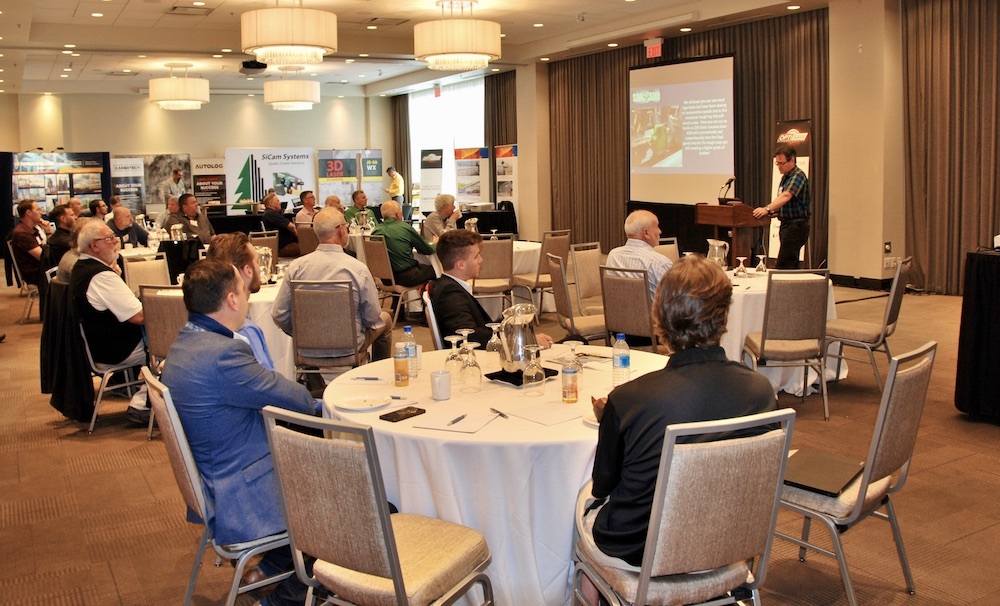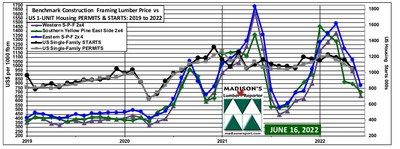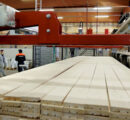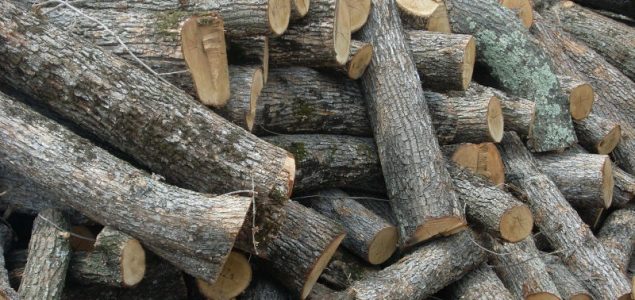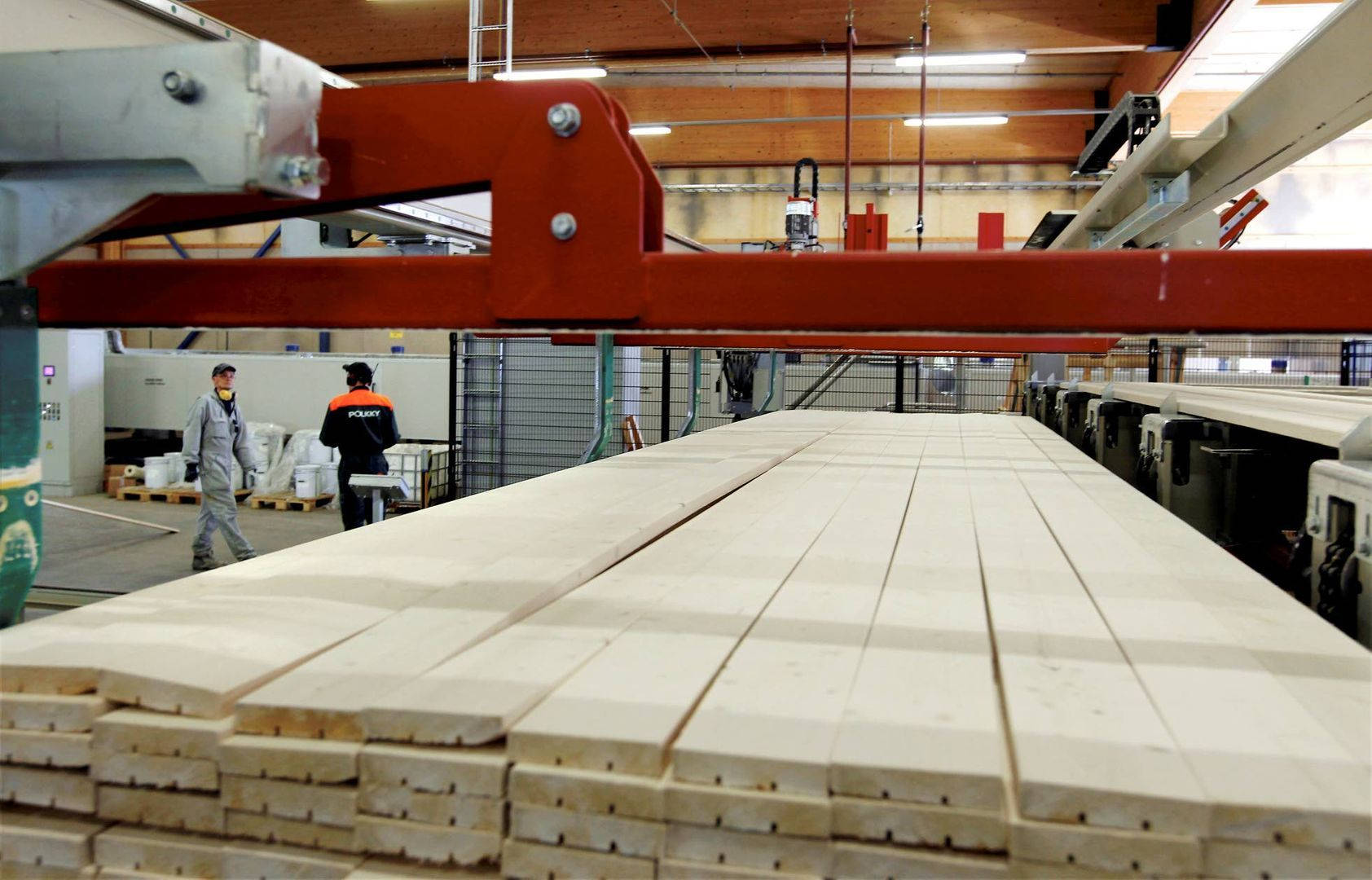As lumber prices level off with more supply available in North America, sawmillers are yet again challenged to do more with less. In B.C. in particular, as government policies shake up the tenure system, mills must adapt to the new regime and make the most of what’s available.
Ideas for processing more wood, consuming fewer logs and experiencing less downtime were introduced and discussed at OptiSaw – the sawmilling optimization and automation forum – held last week in Kelowna, B.C.
Anti-deviation
Marty Vatkin with Saw+ADD began the day of in-person sessions with an introduction of their anti-deviation solution for bandsaws and roundsaws. Saw+ADD uses force sensors to measure and react to forces that could lead to deviation, automatically slowing the feed speed when necessary.
By reacting to and preventing deviation, mills can increase their production speed knowing that it will not affect quality or lead to saw wreaks and downtime.
Vatkin, a former filer, noted that a big advantage of preventing deviation is in the filing room. “The big difference is for the filing room staff. When the saws come down there is very little work to do to them.” When saw life increases, filers – who are in high demand across North America – can be used for other essential work to keep the mill running smoothly.
Vatkin shared payback statistics from a recent installation at a mill where they are producing 53,000 board feet an hour. Factoring in payback from target size, up time, production increases, wood grade opportunity cost, and saw savings, the mill’s productivity increase was calculated to be more than $3 million in a year.
Locking out
A planer safety pilot project at a Fort St. James, B.C., sawmill was the subject of the next presentation, given by UBSafe’s control systems designer, Steve Cuddington. The project involved WorkSafeBC, the BC Forest Safety Council and Manufacturing Advisory Group, and resulted in the provision of three safeguarding approaches for industry.
Cuddington went into thorough detail about the systems installed, which included control system isolation devices that enable lockout of a linked system, bringing the entire line to a zero-energy state before operators can enter the area.
The project’s system was found to be compliant with B.C. legislation, verified and validated, Cuddington said.
Another component of the project was to introduce shot pins on the planer to lift components and enable jam clearing. As a result, downtime from planer related jams was reduced by 50 per cent.
Ultrasound applications
Jan Strycek, president of Airstar, spoke next on how ultrasonic systems are able to detect internal defects in wood products to fully optimize production quality.
Thus far, Airstar has successfully tested detection of hardwood vertical splits, defects in eucalyptus and radiata pine, finger joint defects, engineered wood delamination or disbonds, as well as measure MDF density and veneer quality.
Strycek shared examples of where their systems are in place, such as a 16-channel defects detector in a solid eucalyptus mill, blow detectors in plywood mills, and a vertical split scanner at an Australian hardwood mill.
“The goal is to prevent a visual defect that would lower the value of the boards,” Strycek said.
CT solutions
CT scanning was the subject of two presentations at OptiSaw. First, Norvin Laudon, resident director at MiCROTEC Vancouver, discussed the method and equipment needed to connect CT log scanning to a headrig, allowing a sawyer to make immediate decisions on what sawing solution can provide the highest-value boards.
“You’ve got all this potential value with this big CT scanner. The question is, ‘How does that actually happen?’” Laudon said.
He shared an example of a close-coupled layout where the CT scanner is placed just before the debarker. The CT scanner fingerprints between 50 and 100 logs that flow onto buffer decks. Headrig scanners – using stereoscopy to map out a full 3D image of the log – pick up the fingerprint and execute the solution.
MiCROTEC’s Logeye 901 Stereo scanners are able to provide a 3D shape with no occlusions, track and control log rotation, provide visual feedback of the pattern being sawn, and interact with the operator on value of current position. The scanners create a 3D image while the log is being rotated, eliminating the time needed for a log to settle before being scanned.
Isabelle Duchesne, research scientist with the Canadian Wood Fibre Centre, shared the findings from a case study using X-ray CT scanning on plantation-grown white spruce. Researchers evaluated the effects of sawing optimization strategies to determine if knowing the internal defects of a log can increase lumber value recovery.
The study concluded that CT scanning has the potential to increase lumber value by up to 23.5 per cent in smaller plantation trees. The lumber value, however, is dependent on data processing speed and sawmill equipment precision.
“In small logs you have less space for error,” Duchesne said. “If you use it improperly you could end up with just chips.”
AI advantages
Gilles Gauvin, sales manager for Carbotech/Autolog, spoke on their introduction of machine learning (AI) to the Autolog Prograder – a linear scanning and optimization system for automatic lumber grading.
Autolog trialled the AI software with Forex, a stud mill running spruce and fir in Ferme-Neuve, Que., where they struggle with compression wood and wood distortion. After three months of teaching the machine, the Prograder saw improvements on detection of rot and compression wood.
Through the trial, they learned the AI can be installed on an older version of the Prograder, which reduces investment costs by avoiding a complete system upgrade. “We can install the system parallel and get it to work with the existing system,” Gauvin said.
Other benefits include faster start-up and a faster learning curve for operators.
Wood condition study
UBC associate professor Julie Cool spoke next to share the results of a research project with the Department of Wood Science to understand effect of wood condition on sawing performance and monitoring.
The researchers aimed to understand the potential of online monitoring with sensors. They tested a microphone, acoustic emission sensor and accelerometer to assess cutting power, waviness and sensor data acquisition.
“We want to understand not only what’s happening with the wood, but also what monitoring system makes the most sense,” Cool said.
Cool shared the performance results of each of the sensors and noted that the accelerometer was the most successful at detection. The researchers plan to build on the results and conduct more tests to validate and improve monitoring and prediction models.
Three-in-one
Jessy Ross and Benoit Tremblay gave the final presentation of the day, introducing SmartMill’s 3-in-1 Smart-Trim solution – the result of four years of research and development.
The Smart-Trim is a lug loader, optimizer-linked positioning system, and a multi-saw precision trimmer, all in one. Unlike a conventional trimming system, the saws are fixed and boards are brought into position via Bosch servo-positioners.
The Smart-Trim’s footprint is ideal for compact mill environments, saving, in one customer’s case, 40 feet of space that can now be used for additional bins or storage. Operationally, the system allows for an infinite basket of product lengths within the same production line.
Watch for future OptiSaw events by checking out our website.
